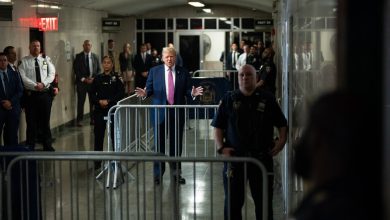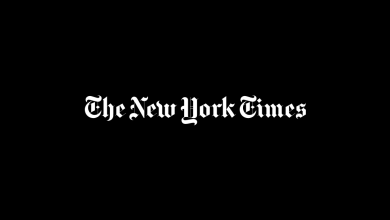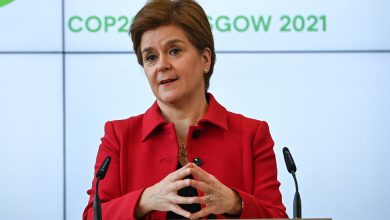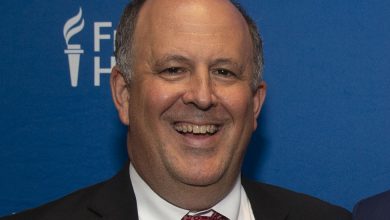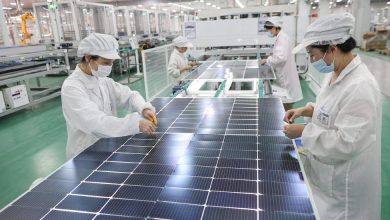Growth Is Surging in Biden’s Economy. Why Don’t Voters Feel Better?

President Biden is contending with an uncomfortable disconnect: The economy grew at the fastest pace since 1984 last year, but voters are downright pessimistic about economic conditions and their own financial prospects.
The divide traces back to the lingering pandemic and high prices, economists said. Inflation is running at its fastest pace since 1982, eroding gains and eating away paychecks as even robust wage increases struggle to keep pace. And despite vaccines, life has yet to return to normal in the way many people once expected.
The disparity poses a significant challenge for Mr. Biden and his party ahead of the November midterm elections. Faltering consumer confidence in the economy — and Mr. Biden’s handling of it — could be a liability as Democrats battle to keep control of both the House and Senate.
Mr. Biden and his top advisers are trying to turn attention toward the positives: emphasizing how rapidly the economy has recovered and that wages are rising, and touting efforts to fix snarled supply chains and rebuild domestic manufacturing.
“We are finally building an American economy for the 21st century, with the fastest economic growth in nearly four decades, along with the greatest year of job growth in American history,” Mr. Biden said in a statement following the release of fresh gross domestic product data on Thursday.
But price gains have complicated that narrative.
The new G.D.P. figures show that the economy has more than fully recovered from its pandemic hit, but a big chunk of that progress evaporates when you factor in recent price gains. In fact, growth is still falling short of its prepandemic trend after adjusting for inflation.
The bite that inflation is taking out of the recovery is palpable in everyday life. Workers are seeing their wages rise at the fastest pace in decades — but as they have to shell out more for couches, used cars, steaks and frozen chicken, many are finding that today’s bigger paycheck doesn’t go as far as last year’s smaller one. While the unemployment rate has dropped much faster than almost anyone predicted, millions remain on its sidelines as child-care issues and coronavirus fears persist.
“It’s kind of hard to be cheerful when there’s still a pandemic raging,” said Ian Shepherdson, chief economist at Pantheon Macroeconomics. Plus, “pocketbook issues really are important.”
The contrast between how the economy is doing on paper and how it feels on the ground has made it difficult for Mr. Biden to capitalize politically on what is, by most measures, a historically strong economic recovery even after accounting for rising prices.
Understand Inflation in the U.S.
- Inflation 101: What is inflation, why is it up and whom does it hurt? Our guide explains it all.
- Your Questions, Answered: We asked readers to send questions about inflation. Top experts and economists weighed in.
- What’s to Blame: Did the stimulus cause prices to rise? Or did pandemic lockdowns and shortages lead to inflation? A debate is heating up in Washington.
- Supply Chain’s Role: A key factor in rising inflation is the continuing turmoil in the global supply chain. Here’s how the crisis unfolded.
Mr. Biden might take some comfort from the last president to experience a similar combination of strong growth and rapid inflation: Ronald Reagan. Mr. Reagan, too, faced an economy struggling with rising prices and snarled supply lines early in his term. He, too, initially struggled to convince Americans that the economy was on the upswing. Yet in 1984, his message of “morning in America” carried him to a landslide re-election victory.
There are important differences between the two eras. Mr. Reagan took office near the peak of the “Great Inflation” of the late 1970s and early 1980s, when interest rates were very high; by 1984, price growth and borrowing costs both had moderated. Economic growth also accelerated near the end of Mr. Reagan’s first term, whereas now most forecasters expect growth to slow as the post-pandemic boom fades. And Mr. Reagan ran for re-election in an era in which views of the economy were much less divided along partisan lines than they are today.
The conundrum Mr. Biden is facing shows clearly in polling and survey numbers.
A Gallup survey conducted this month found that Americans view the economy more negatively than positively: Only 29 percent said that the economy is improving, while 67 percent believe it is getting worse.
Consumer expectations data produced by the Federal Reserve Bank of New York has shown that a high share of consumers expect to be financially worse off a year from now: 26.3 percent in December, compared to 9.9 percent at the end of 2019, before the onset of the coronavirus. That change has come as inflation expectations tracked by the same survey have surged.
Part of the gloominess inevitably ties back to the long-lasting pandemic. While people harbored hope that the economy would reopen and ordinary life would resume once vaccines were readily available, continued waves of infection have prevented that from happening.
“There was a lot of optimism a year ago,” said Karen Dynan, a Harvard economist and former Treasury official in the Obama administration. “We’d gotten the vaccines faster than we’d thought, and we thought our lives were going to be able to go back to normal, and people just expected the economy to come along with that. And maybe that as a little naïve.”
Getting voters to feel like they are benefiting from recent progress toward restoring the economy probably hinges on two things: Bringing the pandemic under control and bringing inflation to heel.
Price gains are expected to fade this year, partly on their own and partly as a result of fiscal and monetary policy. While Congress and the White House pumped a lot of money into the economy last year in the form of expanded unemployment insurance, one-time checks and other benefits, that support is waning, which means that consumers will have less new money in their pockets to spend this year. As demand slackens, it may allow beleaguered supply chains to catch up.
Inflation F.A.Q.
What is inflation? Inflation is a loss of purchasing power over time, meaning your dollar will not go as far tomorrow as it did today. It is typically expressed as the annual change in prices for everyday goods and services such as food, furniture, apparel, transportation and toys.
What causes inflation? It can be the result of rising consumer demand. But inflation can also rise and fall based on developments that have little to do with economic conditions, such as limited oil production and supply chain problems.
Where is inflation headed? Officials say they do not yet see evidence that rapid inflation is turning into a permanent feature of the economic landscape, even as prices rise very quickly. There are plenty of reasons to believe that the inflationary burst will fade, but some concerning signs suggest it may last.
Is inflation bad? It depends on the circumstances. Fast price increases spell trouble, but moderate price gains can lead to higher wages and job growth.
How does inflation affect the poor? Inflation can be especially hard to shoulder for poor households because they spend a bigger chunk of their budgets on necessities like food, housing and gas.
Can inflation affect the stock market? Rapid inflation typically spells trouble for stocks. Financial assets in general have historically fared badly during inflation booms, while tangible assets like houses have held their value better.
The Federal Reserve is also preparing to raise interest rates, signaling that an initial increase is coming at its meeting in March; it has already begun to pull back its additional support for the economy. Higher borrowing costs should further cool off consumer and business demand, slowing hiring and wage growth in the process.
The trouble for the administration is that if the Fed slows down the economy dramatically in its bid to tame inflation, voters may not end up happier: Fast growth and fast inflation and slow growth and slow inflation may both prove to be bad outcomes, from a worker’s perspective.
“Nirvana would be strong growth and low inflation,” said Nela Richardson, chief economist at payroll processor and employment data provider ADP. “That would be harder to pull off.”
Policymakers hope that the Fed will be able to engineer what economists call a “soft landing,” stabilizing prices while also managing to keep the job market relatively strong and growth chugging along steadily.
Yet economists have warned that accomplishing that could be a challenge, and the timeline may clash with America’s political cycle. Price gains are expected to begin to moderate by November, but high costs may not have completely evaporated by then.
The Fed in December projected that inflation would be running at about 2.6 percent by the end of the year, down sharply from the current pace — it is expected to come in at 5.8 percent in a report set for release tomorrow — but still above the central bank’s 2 percent goal.
The Fed is not partisan and operates independently of the White House. But its policies can affect political outcomes.
“The question is, do you want to be in the situation where demand is curtailed and we’re slowing down headed into an election cycle?” Ms. Richardson said. “There’s a lot of risk there.”
And in the meantime, Republicans have been zeroing in on rising prices, blaming them on the administration’s 2021 relief package and arguing that they detract from economic progress.
“There are real red flags here, with raging inflation, a massive drop in real disposable income and G.D.P. growth driven primarily by a temporary buildup in inventories,” Kevin Brady, a Republican representative from Texas, said in a release following the G.D.P. report. “Given that many Americans have lost confidence in his competency to heal the economy, it’s too soon for President Biden be celebrating with the challenges workers and families face.”
Talmon Joseph Smith contributed reporting.
